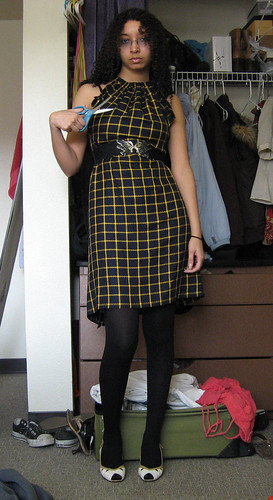
Making the first cut can be the toughest part of sewing. You never know if it will turn out right, and the fear that you will royally screw up sits there and stares at you. Cutting your pieces out is probably the most crucial part of sewing. If your pieces aren't cut properly, chances are your piece will end up wonky. But don't let the fear cripple you, o mortals, for most of the time you can find a way to work with your mistakes if you should happen to make one.
If you're new to diy and crafting, you might want to start with something simple or do a practice run on something that you won't be too depressed about if you mess up. it might also boost your confidence a bit.
Cork boards are good to cut on since you can stick your pins into it to hold fabric and patterns in place and it's hard enough to cut on. You can also stick pins in carpet but corkboard holds better and is a better surface to cut on.
Fold your fabric flat and iron it if necessary. Most patterns require pieces that need to be cut twice; save yourself work by cutting it once out of your folded fabric. This also ensures that you will have a left piece and a right piece.
If you don't have enough fabric for all the pieces if you cut them on the fabric while its folded, try opening the fabric up. This will give you a little more fabric to work with. When cutting out pieces that require two, cut the first piece, flip your pattern piece over, and then cut the second one. That is important so you will end up with one left piece and one right piece.
Good, sharp sewing shears are a big help. If you're having trouble cutting a straight line, you may find better scissors will help.
Don't have a pattern piece? Dissappearing ink pens and tailor's chalk are your friends. They're great for drawing the lines you want to cut when altering a piece. Be sure to read the directions and test it on your fabric. I find that the pencils don't really work so well, so don't be fooled by them. Get real tailer's chalk. If you don't want to invest a lot in sewing supplies, I do occasionally use one of my art pens that I know erases easily (it comes out on my fingers!) to draw cutting lines. You can also use a sharpy in places where the line won't really show on the outside, such as seam allowances and hems. I wouldn't recommend using sharpy on darts or on edges you don't plan to tuck in or otherwise finish. You can also just cut the sharpy lines off.Don't forget to leave seam allowances. If you're making something shorter, make sure to leave enough fabric to finish your new hem. Most patterns use a 5/8" seam allowance. I use a half inch and a full inch for zipper seams. It gives me extra room to play with, and I find it easier to insert zippers with the larger seam. Occasionally, I use smaller seam allowances if I barely have enough fabric.
Cutting it close,
Ivy Frozen

No comments:
Post a Comment